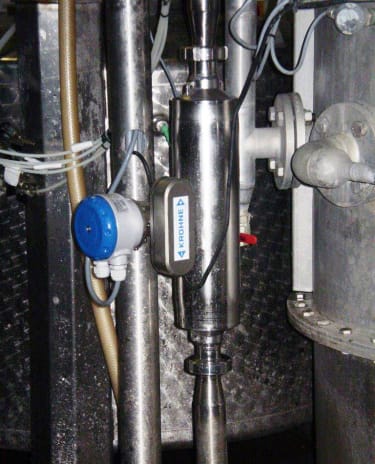Flow measurement of potato mash in Vodka production
Application Report | Food & Beverage
- Measuring the volume flow rate of fermented mash fed into the distillation column
- Reliable solution to automate the process and reduce production time
- Monitoring the feedstock to finished product ratio

Background
The family run Chase distillery, located in Hereford, England, produces the award winning Chase Vodka which is the World’s first super premium English potato Vodka. The entire process from seed to bottle takes place on the Chase estate ensuring that a close eye can be kept on all stages from growing the potatoes to distilling and bottling.
Measurement requirements
Vodka production involves a fermentation process starting with the mashing of potatoes and the addition of a brewer’s yeast. After about a week, the fermented potato mash is distilled four times in a bespoke copper batch pot and then twice more in a rectification column. In the past, the distillery used a manual method to monitor the flow of fermented potato mash into the distillation column. However, it was planned to automate the process, so Chase were looking for a flowmeter that was capable of measuring the flow rate of the medium at the distilling stage.
The density of the medium going through the meter can vary from 0.95 to 1. kg/l / 59 to 69 lb/ft3 and flows at a rate of 2000 l/h / 54 lb/m with pressure of 1 barg / 15.5 psig at a temperature of 30 °C / 86 °F. With the available space being limited, Chase required a meter that had a small installation envelope, but could still measure accurately and was capable of being CIP cleaned at 65 °C / 150 °F.
KROHNE Solution
After careful consideration, the Chase distillery decided on KROHNE’s OPTIMASS 1300. The Coriolis mass flowmeter was installed in a vertical pipe run feeding the distillation column. The OPTIMASS 1300 has a dual straight tube design which makes it ideal for use in hygienic applications as there are no crevices or bends for bacteria to gather and the meter can be easily drained and cleaned. Due to the hygienic nature of the application the OPTIMASS 1300 was supplied with hygienic fittings and also has all of the necessary hygienic industry approvals. Initially, the OPTIMASS 1300 has been used with a local display. However, in the future it is planned to interface the meter with the PLC using mA outputs to measure volumetric flow, density and temperature.
Customer benefits
The OPTIMASS 1300 has enabled Chase to monitor the feedstock to finished product ratio accurately. Since installation it has also reduced production time by highlighting an underperforming feed pump that was increasing the mash charging time which in turn lengthened the production time.
Tim Nolan, engineering manager at Chase, is very pleased with the performance of the OPTIMASS 1300, “Installing the KROHNE meter has meant that we can automate the process and ultimately reduce production time. It also allows us increased flexibility as we can install the meter on other parts of the process to verify efficiency,” he continues, “KROHNE have supplied us with a meter that complies to our hygienic requirements and has proved to be very reliable.”


